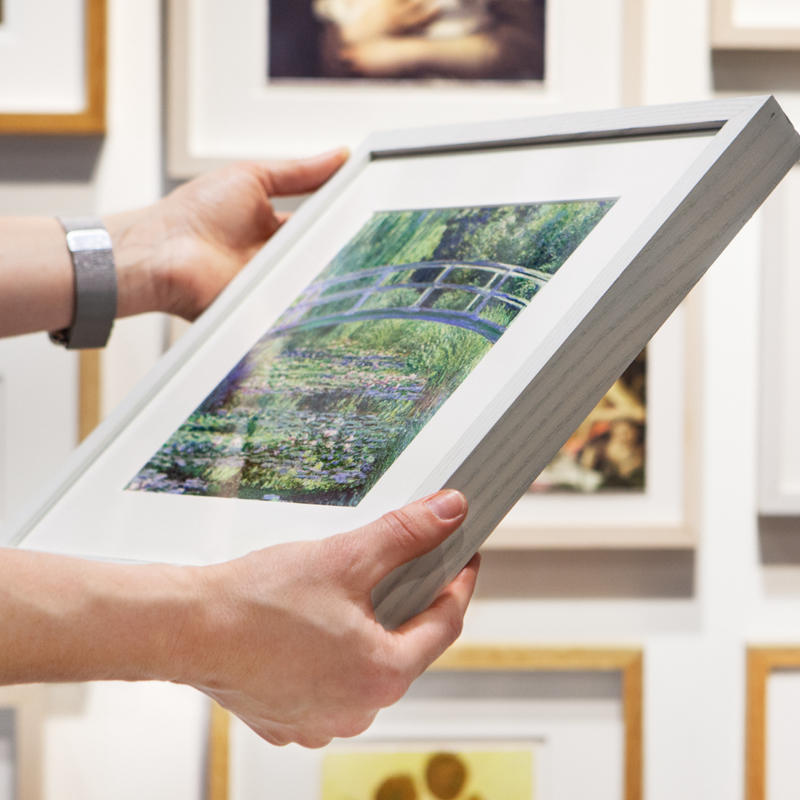Pierre-Auguste Renoir, 'The Umbrellas', about 1881-6
About the work
Overview
This painting places us in a busy Parisian street close to six principal figures who fill the foreground. A milling crowd behind them almost completely blocks out the boulevard beyond. The top quarter of the picture is mostly filled by a canopy of at least a dozen umbrellas.
Painted in two stages, with a gap of around four years between each stage, it shows the change in Renoir’s art during the 1880s, when he was beginning to move away from Impressionism and looking instead to classical art. The group on the right, which includes a mother and her two daughters and the woman in profile in the centre, is painted in a characteristically Impressionist manner with delicate feathery touches of rich luminous tones. On the left of the composition, completed during the second stage, Renoir adopted a more linear style. The figures here, including the full-length young woman and the man standing behind her, have clearly defined outlines, precisely drawn features and a greater sense of three-dimensional form.
Audio description
Listen to an audio description of Pierre-Auguste Renoir's 'The Umbrellas'
Transcript
This is a description of an oil painting by Pierre-Auguste Renoir called The Umbrellas. It was first painted in about 1881 and probably finished in 1886. It is a tall painting: just under 2 metres high and a metre wide. It is in a gilded frame with a relief pattern and features a bustling crowd on a busy Parisian boulevard. Some of the people on the street have dark umbrella’s open, others do not. One woman is closing hers, which suggests the rain might have just stopped. The size of the painting draws us into this busy scene. Towards the top of the painting, the skyline is dominated by the graceful curves of umbrellas, ranging in various shades of blue. Above this, there are glimpses of treetops and the upper story of an apartment block. The trees are painted in bright greens and hazy orange indicating that this might be a spring shower. These lively colours bring a dash of brightness and lightness to the painting. The rest of the painting is filled by the crowd who are tightly packed in causing one man - on the right - to raise his umbrella high above the crowd to push his way through. The people are depicted in a lively manner, but the tonal palette is quite subdued in predominantly blue, black and brown. Our attention is drawn to a family group on the right and a young woman on the left who gazes directly out at us. The family are a fashionably dressed young mother and her two daughters. Placed
centrally, standing behind her young children the young mother is leaning slightly forward and holding an open umbrella in one gloved hand over her head. She wears a long, inky blue dress with a bustle, a dark blue, fur cape and small, flowery bonnet. She has soft light blonde curls and is gazing down at her youngsters with a slight smile. Standing side on to us, on the far right is the elder of the two girls who is about ten. She is at the edge of the painting and is not fully depicted. She wears a blue-grey coat and a cream lace hat over her auburn ponytail. She stands close behind her little sister, who faces us with a pale face and dark eyes. This girl is about 6 and wears a short, lace trimmed coat and a ribboned bonnet. She clutches her plaything: wooden hoop and stick - whilst gazing solemnly out at us. Both mother and elder sister have a hand clamped on her shoulders – possibly trying to restrain her or guide her under the umbrella. A small space in the crowd has opened up between this well clad family and the more simply dressed young woman on the far left. Placed close together in the composition, but worlds apart – Renoir shows these two young women as a mirror contrast to one another other. This woman has chestnut brown hair pinned up at the back. She is wearing a plain long dark grey/blue skirt and matching jacket, that is nipped in at the waist, over a black top. She has no hat or umbrella and stares directly out at us, with dark brown eyes. Some have interpreted her expression as soulful or tragic. The woman has a large band box
used for carrying hats over her left arm and this with her simple clothing might indicate that she is a milliners assistant making a delivery. With her other hand she holds the folds of her skirt up away from the damp. Behind this young woman is a bearded man dressed in a brown coat. He is holding an umbrella, which partially conceals his black hat, and it seems like he's looking down at the woman. Beyond these central figures, the painting portrays a bustling crowd, depicted with less detail. Only parts of their heads, arms, and legs are shown, but everyone is still formally dressed in coats and hats, contributing to the lively atmosphere of the scene. Renoir was a founding member of Impressionism, a style characterised by painting rapidly on the spot to capture a moment either out in nature or the ebb and flow of city life. The artist seems to have painted this picture initially in 1881 in a loose, and feathery style. However, he was becoming dissatisfied with this rapid approach. Scientific research shows that he repainted the left-hand side of this painting in a crisper more severe style using tighter brushstrokes.
Key facts
Details
- Full title
- The Umbrellas
- Artist
- Pierre-Auguste Renoir
- Artist dates
- 1841 - 1919
- Date made
- About 1881-6
- Medium and support
- Oil on canvas
- Dimensions
- 180.3 × 114.9 cm
- Inscription summary
- Signed
- Acquisition credit
- Sir Hugh Lane Bequest, 1917, The National Gallery, London. In partnership with Hugh Lane Gallery, Dublin.
- Inventory number
- NG3268
- Location
- Room 41
- Collection
- Main Collection
- Frame
- 18th-century French Frame
Provenance
Additional information
For further information, see C. Bailey, 'The Umbrellas (Les Parapluies)' in C. Bailey, 'Renoir, Impressionism, and the Full-length Format: Impressionism and Full-Length Painting', New Haven, 2012, pp. 138-165.
Exhibition history
-
2012Renoir, Impressionism, and Full-Length PaintingThe Frick Collection7 February 2012 - 13 May 2012
-
2012Long Loan to The Hugh Lane (2012 - 2019) (Group A)Dublin City Gallery The Hugh Lane31 December 2012 - 20 October 2019
-
2024National TreasuresLeicester Museum and Art Gallery10 May 2024 - 1 September 2024
Bibliography
-
1908
H.P. Lane, Illustrated Catalogue with Biographical and Critical Notes: Municipal Gallery of Modern Art, Dublin 1908
-
1908S. Harrison, Illustrated Catalogue, with Biographical and Critical Notes, Dublin 1908
-
1917L.H. Cust, 'Manet at the National Gallery', The Burlington Magazine, XXX/168, 1917, pp. 110-5
-
1917R. Fry, 'The Sir Hugh Lane Pictures at the National Gallery', The Burlington Magazine, XXX/169, 1917, pp. 148-53
-
1918A. Vollard, Pierre-Auguste Renoir: Paintings, Pastels and Drawings, Paris 1918
-
1920G. Geffroy, 'Renoir, peintre de la femme', L'art et les artistes, 4, 1920, pp. 151-62
-
1922C. Bell, Since Cézanne, London 1922
-
1926G. Coquiot, Renoir, Paris 1926
-
1932T. Bodkin, Hugh Lane and his Pictures, Dublin 1932
-
1944M. Drucker, Renoir, Paris 1944
-
1945C. Bell, National Gallery Books 6. Auguste Renoir: Les Parapluies, London 1945
-
1945O. Demus, 'The Literature of Art: Auguste Renoir: Les Parapluies', The Burlington Magazine, LXXXVII/511, 1945, pp. 258-9
-
1946Martin Davies, National Gallery Catalogues: French School, London 1946
-
1951W. Pach, Renoir, London 1951
-
1957Martin Davies, National Gallery Catalogues: French School, 2nd edn (revised), London 1957
-
1970Davies, Martin, and Cecil Gould, National Gallery Catalogues: French School: Early 19th Century, Impressionists, Post-Impressionists etc., London 1970
-
1971F. Daulte, Auguste Renoir: Catalogue raisonné de l'oeuvre peint, I: Figures 1860-1890, Lausanne 1971
-
1982W. Gaunt, Renoir, Oxford 1982
-
1985J. House, A. Distel and L. Gowing, Renoir (exh. cat. Galeries Nationales du Grand Palais, 15 May - 2 September 1985), Paris 1985
-
1988B.E. White, Renoir: His Life, Art and Letters, New York 1988
-
1988National Gallery, 'Pictures Cleaned and Restored in the Conservation Department of the National Gallery, 1987', National Gallery Technical Bulletin, XII, 1988
-
1990D. Bomford, R. White and L. Williams, Impressionism (exh. cat. The National Gallery, 1990), London 1990
-
1993R. White and J. Pilc, 'Analyses of Paint Media', National Gallery Technical Bulletin, XIV, 1993, pp. 86-94
-
1993A. Distel et al., Great French Paintings from the Barnes Foundation: Impressionist, Post-Impressionist and Early Modern (exh. cat. National Museum of Western Art (Tokyo), 22 January - 3 April 1994), New York 1993
-
1994J. House, Impressionisim for England: Samuel Courtauld as Patron and Collector, London 1994
-
1994C. Phillips, 'National Gallery, II: Sir Hugh Lane's Pictures', in J. House, Impressionism for England: Samuel Courtauld as Patron and Collector, London 1994
-
1995P. Smith, Impressionism: Beneath the Surface, New York 1995
-
1998J. Leighton, 'Taking a Closer Look: Art Historians, Restorers and Scientists', Leids Kunsthistorisch Jaarboek, XI, 1998, pp. 29-33
-
2000R. O'Byrne, Hugh Lane, 1875-1915, Dublin 2000
-
2001
C. Baker and T. Henry, The National Gallery: Complete Illustrated Catalogue, London 2001
-
2003S. Pacaud, Il était une fois… La condition de la femme à la belle Époque à travers la carte postale, Romorantin 2003
-
2004A. Kelly, 'The Lane Bequest: A British-Irish Cultural Conflict Revisited', Journal of the History of Collections, XVI/1, 2004, pp. 89-110
-
2005C. Harrison, Painting the Difference: Sex and Spectator in Modern Art, Chicago 2005
-
2006A. D'Souza and T. McDonoughs (eds), The Invisible Flâneuse? Gender, Public Space and Visual Culture in Nineteenth Century Paris, Manchester 2006
-
2006C. Riopelle, Manet to Picasso, London 2006
-
2006S.M. Søndergaard, Women in Impressionism: From Mythical Feminine to Modern Woman (exh. cat. Ny Carlsberg Glyptotek, 6 October 2006 - 21 January 2007), Milan 2006
-
2012C. Bailey, 'The Umbrellas (Les Parapluies)' in C. Bailey, Renoir, Impressionism, and the Full-length Format: Impressionism and Full-Length Painting, New Haven 2012, pp. 138-65
About this record
If you know more about this work or have spotted an error, please contact us. Please note that exhibition histories are listed from 2009 onwards. Bibliographies may not be complete; more comprehensive information is available in the National Gallery Library.












